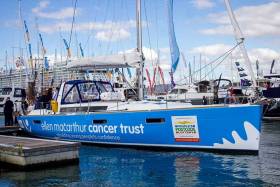Displaying items by tag: Hamble Yacht Services
Ellen MacArthur Cancer Trust Receive Keys to Specially Adapted Beneteau Yacht
The Ellen MacArthur Cancer Trust have proudly been handed ownership of their highly anticipated new yacht, which will enable them to better support young people from the North of England and Scotland particularly those with mobility issues resulting from their cancer treatment.
Dame Ellen MacArthur, who founded the Trust with the aim of rebuilding young people's confidence in their recovery from cancer, joined Ash Overton of Ancasta, and Head of Charities Clara Govier from People's Postcode Lottery on the boat at the 2016 Southampton Boat Show to receive the keys.
The purchase was made possible after the Trust received an additional £200,000 at the People's Postcode Lottery Charity Gala from players of People's Postcode Lottery to invest into a yacht to improve the experience of young people at their newest base in Largs, Scotland, which opened in early 2013. With advice and support from Beneteau, Ancasta and Hamble Yacht Services Refit and Repair the boat was carefully selected, purchased and modified to best support the requirements of the Trust's young people.
Ellen expressed the charity's gratitude, "It's been a big day for the Ellen MacArthur Cancer Trust, it's a step that wouldn't have been possible without the massive support from players of People's Postcode Lottery, the Ancasta Group, and Beneteau so a huge thank you!" She continued "A magnificent job really has been done".
This is an important purchase for the Trust and the young people it supports, as it will improve the quality of the experience for those with mobility issues. The Trust supports a number of young people who have suffered from brain tumours and sarcomas, treatment of which affects their coordination, balance or may result in an amputation, limiting their ability to move around a boat.
Modifications made by Hamble Yacht Services Refit and Repairs to the boat, such as the fitting of extra handrails and altering the cabin space, will allow young people with these issues to have a better quality experience. The stern of the boat also lowers to pontoon height to enable easier access when the young people are embarking and disembarking from the boat.
Further to this, the yacht will expand the Trust's capacity to be able to offer 'Day Sails' for the families of young people who are too ill to join the four day trips.
Ancasta, the largest yacht brokers in Europe, have supported the Trust from the start of the purchase process enabling them to secure the Beneteau Oceanis 45. Ash Overton of Ancasta commented, "It has been a wonderful project to be involved with, working closely with the Trust to select and modify a yacht perfect for their needs. We can't wait to see it in action".
The yacht will now make its way up to the Largs base where it will join the Trust's operations ready to start the sailing season in spring 2017.
The Ellen MacArthur Cancer Trust is a national organisation set up 13 years ago by internationally renowned yachtswoman Dame Ellen MacArthur that gives young people in recovery from cancer the opportunity to take part in sailing trips to rebuild their confidence. The Trust works with every young person Principal Treatment Centre in the UK and a growing number of Designated Units in the UK. It receives no government funding and relies entirely on voluntary donations to provide sailing trips free of charge to the young people.
























































